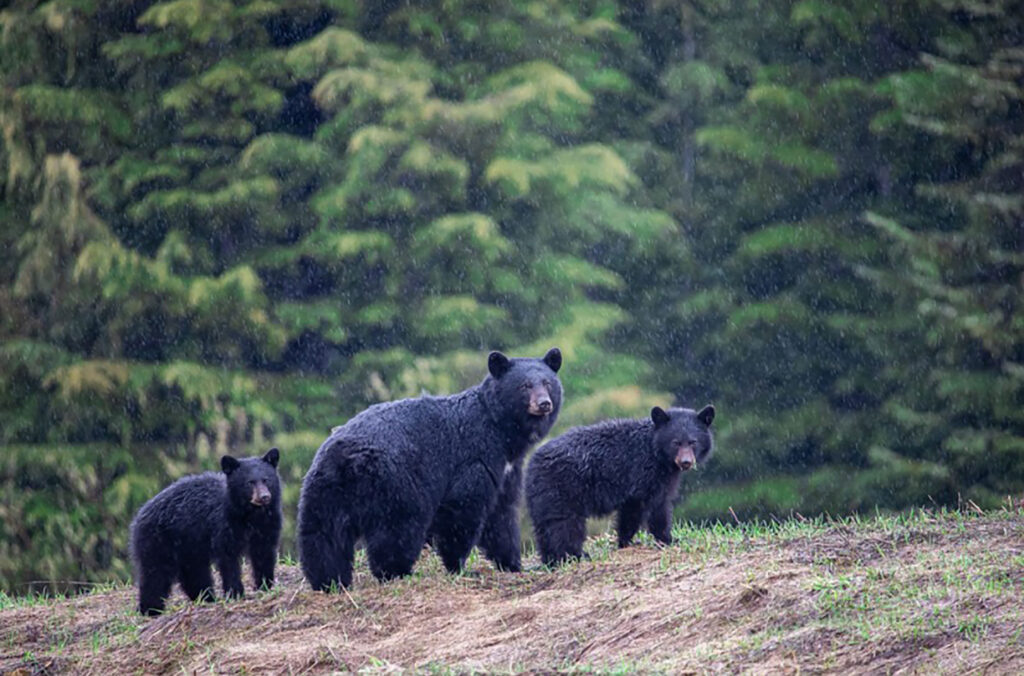HEADER PHOTO: WHISTLER PHOTO SAFARIS / JASON COLEMAN – Priscilla and two of her cubs, Daisy and Dante.
The black bear on the road in front of us lifts its nose to the wind. Did she smell us before she saw us? Large, padded paws move toward us, not in a rush, curious. Her coat is a glossy black and her eyes are two dark brown intelligent pools. Who has come to her home in the wilds of the Callaghan Valley? And what do we want?
As she sidles around the edges of the vehicle I notice a white blaze on her chest. A marker that our guide from Whistler Photo Safaris uses to identify her as Priscilla, who’s roughly 12 years old and one of the main matriarchs of the valley. This spring, she presented her fourth set of cubs, which she typically keeps with her until they’re 14 to 18 months old.
We came to see you, Priscilla. Because seeing a black bear in the wild makes you hold your breath. You’re in the presence of a powerful animal that’s played such a prominent role in human culture; from the bears that adorn our beds to the ones on TV shows. There’s something about these creatures that capture our hearts. When Priscilla decides to amble off into the lush forests, I wonder if she knows she’s taken a bit of our hearts with her.

First Nations and Bears
At the Squamish Lil’wat Cultural Centre (SLCC), you’ll find references to Míxalh / Mixálh (bears) everywhere. They adorn the house and welcome posts, as well as being animated in the masks worn during dances and ceremonies. Along the Salish Stroll, which stretches into the forest area behind the main centre, a plaque tells us how significant this animal is to the Squamish Nation and Lil’wat Nation who have lived on the lands surrounding Whistler for time immemorial.
“Bear is a respected figure in our forest; we look to the bear to show us what to eat and where to live. As families gather to harvest the berries bears are also there feasting before their winter hibernation.”
Master Carver Xwalacktun (Rick Harry – Sḵwx̱wú7mesh / Kwakwak’wakw / Namgis), is currently carving a new house post to commemorate the 100th anniversary of Squamish Nation’s Amalgamation. Near the base of the post is a bear. As he works, I ask him why he placed the bear there.
“The bear represents the strength and power we need to keep moving forward,” Xwalacktun explains. “It reminds us to stay unified and connected.”
The carving is featured in a curated guided tour Tuesday through Saturday at 11 AM until September 3rd, 2023.
In the image above, which you’ll find in the UNCEDED exhibition currently on at the SLCC, Lead Dancer T’ec Georgina Dan (Líl̓wat7úl) wears the distinctive bear mask. She was flown by helicopter to Nq’el’qámtensa ti Skenknápa (the roost of the Thunderbird, Lil̓wat7úl) / T’ak̲t’ak̲míyi7en tl’a Íń7inyáx̲a7en (the home of the Thunderbird, Sḵwx̱wú7mesh) also known as Black Tusk, for this exhibit, which aims to change the viewer’s perspective on Indigenous peoples’ presence and sense of belonging on the lands in the Sea to Sky. Although Georgina had never been to that area before this is what she has to say about her experience.
“I felt so connected to that place. And to be able to dance in the bear mask the Dancing Song from the Líl̓wat7úl, one of my songs that I really connect to and always have throughout my childhood. I’ve always known the feeling of dancing to that song. But dancing up there, it brought this need to really want to explore how I carry this song all the time.” Quote from the UNCEDED podcast.
The bear was once again present in an experience where the dominating feeling was one of connection. I highly recommend a trip to the SLCC during your time in Whistler, the opportunity to meet and learn from cultural ambassadors like Georgina and Xwalacktun gives you a much greater understanding of the land you’re enjoying, along with insights into our relationship with the animals that also call it home.
Whistler Photo Safari Bear Tour
The Callaghan Valley, which Whistler Photo Safaris have exclusive access to, is a special place in and of itself. Our guide, an expert in the driver’s seat, takes us off-roading and we weave our way through the old-growth forest that hangs with lichen. It feels like a different world.
My daughter, Ella, who’s six, can feel it too. Amped up after seeing Priscilla she turns her face to the sunlight that beams through the tree canopy and breathes in the fresh, alpine air. Then it’s out of the Jeep to explore the ski jump.
I was here during the 2010 Winter Olympic and Paralympic Games, and I remember the roar of the crowds as the athletes shot off this jump and soared into the air like the bald eagles that cruise the skies here. But today, it’s the mountain range that provides the main show. We look out over the ancient peaks of Metal Dome, Brandywine Mountain, Mount Cayley and Powder Mountain, the glaciers sparkling in the distance.
As we make our way back down, Ella scans the forest and roads for Priscilla or one of her friends. The binoculars look huge in her hands and I’m not convinced she’s got them the right way around. We learn that soon the bears will be going into hyperphagia when they eat as much as they can to put on weight to get them through hibernation.
Last year, two bears in Whistler decided not to hibernate, likely because they were finding human-based food sources to get them through. This is dangerous for bears and humans, as the more they become habituated to us, the more likely there is to be conflict. Two simple ways of avoiding this are to give them space (at least 100 metres) and to clear away attractants (like garbage).
I think about what Xwalacktun said about bears, and how they remind us that there’s strength and power in connection. I’m so glad I got to share this magical experience with my daughter. I hope she remembers the thrill of seeing a bear in the wild and understanding how our connection to the world around us strengthens our ability to protect it.
Keep Whistler’s bears wild by never approaching or feeding them. Book a bear tour if you’re looking to learn more about these incredible creatures. If you enjoyed this post, take a read of some of our other bear-related stories.
Spring savings are calling! There’s so much to see and do in spring, you’ll want plenty of time for fun in the sun. Extend your stay and book midweek for increased savings, with 3 nights starting from $135 CAD per night.
For summer, book ahead and save up to 25% on lodging. Plus, you'll receive a free $100 CAD Activity Voucher on stays of 3 or more nights ($200 for 5 nights).
Insider Tip: BC or Washington resident? Sign up for Whistler Rewards to access additional savings and exclusive perks.


